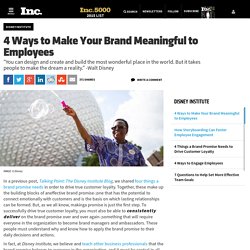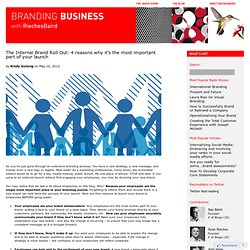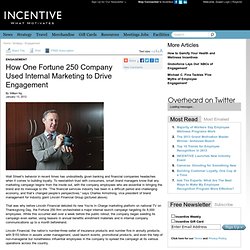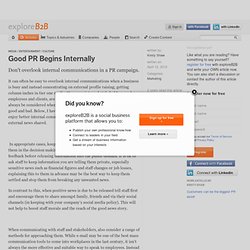

Are Your Employees Keeping Your Brand Promise? Try these eight golden rules… 4 Ways to Make Your Brand Meaningful to Employees. In a previous post, Talking Point: The Disney Institute Blog, we shared four things a brand promise needs in order to drive true customer loyalty.

Together, these make up the building blocks of aneffective brand promise-;one that has the potential to connect emotionally with customers and is the basis on which lasting relationships can be formed. Brand Your Employees, Not Your Organization. Marketing Matters: Is QANTAS using internal marketing to strengthen its brand in the tough aviation market? Having recently had the pleasure (and I don't use this term lightly) of travelling to Singapore and returning from Hong Kong with Qantas, I am pleased to say I was both shocked and delighted by my experience.

I checked in feeling sorry for their employees, 5000 of which are to be sacked; none of them knowing who would lose their job, or when. But they did know that they were going to go, because Alan Joyce had already announced it to the media. For this reason, I wondered about flying Qantas, about how beleaguered the staff would be and how much of this, we, the customers would bear throughout the flight via their overall demeanor and attitude. I had to check in myself electronically, and thought it was an indicator of what was to come; i.e. self service and no frills. However, the staff were smiling and laughing as I entered the cabin, the flight left on time and the male flight attendants were efficient and friendly. What Does Your Employer Branding Fishbowl Look Like? Every company has two distinct brands, its employer brand and its consumer brand.

With the rise of social networking, your company, how you run it and your culture has become a fishbowl — everything you do is on display for all to see. And like it or not, your employees have an abundance of channels for broadcasting their opinions — both negative and positive. Company branding and employer branding aren’t the same, but they intersect to fuel each other.
Many of the same characteristics that motivate consumers also motivate job seekers. Successful companies foster a culture where employees not only like where they work but also believe in the products and solutions they support. The employer brand is comprised of a myriad of factors that contribute to how your employees learn, plan and do their work and personal lives. 1. Today real-time career development can be facilitated with some imagination, technology devices, innovation and focus. 2. 3. How did you rate? 4. 5. 6. 7. 8. 9. The Internal Brand Roll Out: 4 reasons why it's the most imporant part of your launch. So you’ve just gone through an extensive branding process.

You have a new strategy, a new message, and maybe even a new logo or tagline. Now what? HOW TO: Help Employees Talk About Your Brand Online. This series is supported by IGLOO, a leader in helping organizations improve business processes, increase employee productivity and enhance stakeholder engagement inside and outside the organization using social technologies.

For many brand managers, employees' actions online remain a daunting, untamed frontier. The brand's consistent, controlled message to consumers melds with internal messaging and individuals' stories when employees take to the social web. The cautionary tales of the social web's early days — stories of indiscretion, mixed signals and poor communication — have led to an increase in strict policies and careful monitoring of employee social media activities in many cases. But lately, a few savvy brands have changed their internal position about employees' activities on the social web.
ROI of Internal Brand. How's Your Internal Customer Service? by @lkpetrolino Spin Sucks. Incentive Programs - Engagement - How One Fortune 250 Company Used Internal Marketing to Drive Engagement - Incentive Magazine. Wall Street’s behavior in recent times has undoubtedly given banking and financial companies headaches when it comes to building loyalty.

To reestablish trust with consumers, smart brand managers know that any marketing campaign begins from the inside out, with the company employees who are essential in bringing the brand and its message to life. “The financial services industry has been in a difficult period and challenging economy, and that’s changed people’s perspectives,” says Charles Armstrong, vice president of brand management for industry giant Lincoln Financial Group (pictured above). That was why before Lincoln Financial debuted its new You’re In Charge marketing platform on national TV on Thanksgiving Day, the Fortune 250 firm orchestrated a major internal launch campaign targeting its 8,000 employees.
Every new marketing campaign should not only fulfill the external brand promise but also mobilize the organization internally, says Duncan. The Social Business and the Social Brand. Originally posted at InformationWeek.

They’re different–and the same. For starters, there needs to be consistent alignment between the two to generate true business results. There’s some confusion in the marketplace about the difference between a social brand and a social business. First, a couple of quick definitions: Good PR Begins Internally. Don't overlook internal communications in a PR campaign.

It can often be easy to overlook internal communications when a business is busy and instead concentrating on external profile raising; getting column inches in tier one media. However, internal stakeholders, such as employees and clients, are a business’ greatest asset and therefore should always be considered when communicating any news or changes, both good and bad. Below, I have outlined some tips on how businesses can enjoy better internal communications and subsequently, more positive external news shared. In appropriate cases, keep staff informed on company news and share them in the decision making process by asking their opinions and feedback before releasing information into the public domain.